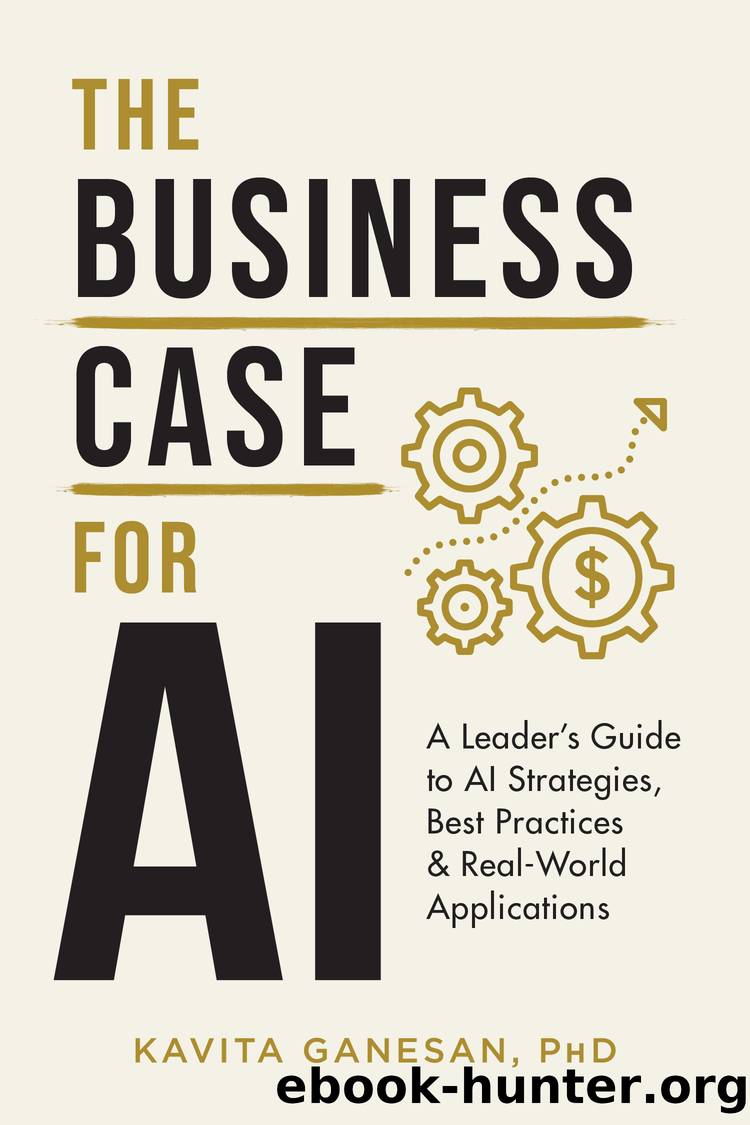The Business Case for AI by Kavita Ganesan

Author:Kavita Ganesan
Language: eng
Format: epub
Publisher: Opinosis Analytics Publishing
Published: 2022-03-14T00:00:00+00:00
Pillar 2: Cultural Readiness
Create Cultural and Mindset Shifts for Embracing AI
Although AI got its start in the 1940s, the adoption of Business AI is still new to organizations. Using AI to improve an organizationâs efficiency, reduce human error, and increase revenues is still a new idea for many companies.
A Gartner poll of 200 business and IT professionals revealed that while 79% of companies were piloting AI initiatives, only 21% had their AI initiatives in production.72 This shows that getting AI to create value for your organization takes a lot more than experimenting with AI. Itâs also about making relevant changes in the organization to bring these initiatives successfully to production. As part of this, creating cultural and mindset shifts is a crucial piece of the puzzle. A big reason why this is important is the confusion around AI.
Business leaders often see AI as magic, developers see it as software engineering with a hint of science, and everybody else guesses what AI truly means. Many fear this âAI technology.â Some fear losing their jobs; others fear contributing to something thatâs evil, or being replaced altogether by this new âAI race.â
According to a survey conducted by the University of Oxfordâs Center for the Governance of AI, Americans fear a future where AI becomes too intelligent.73 When people were asked what kind of impact machine intelligence would have on humanity, 34% thought it would be negative, with 12% leaning toward human extinction! These responses indicate that thereâs going to be resistance toward the adoption of AI, not just by customers but also internally by employees.
Given this, leaders should take proactive steps in shaping employee and customer attitudes toward AI. Letâs look at the six elements for establishing cultural and mindset changes for the long-term adoption of AI.
Cultural Readiness 1: Establish AI Literacy
Literacy is the key for shaping employee attitudes toward AI. This is not just about training your technical teams. Itâs about most employees in your company, technical or not. They should have a base understanding of AI and be able to answer, What is this thing? How does it work? What is the company planning to do with AI? How does it impact job security?
This is so important because it reduces fear and closes the door for false interpretations. Without this base AI literacy, once employees hear about your companyâs plan to integrate AI, they may make their own assumptions and take actions that can negatively impact your companyâs reputation.
For example, if employees think theyâre going to lose their jobs, they may plan a protest in reaction. Some may leak information to the media based on their own interpretation of what youâre going to do with AI. Given the fears and confusion around AI, itâs important to address uncertainties with company-wide education and planning.
Of course, executives, managers, and technical teams will require additional levels of AI understanding. But having a base-level understanding is a start.
AI literacy can also help AI initiatives progress along faster and face less resistance, as collaborating teams will have context on how AI works.
Download
This site does not store any files on its server. We only index and link to content provided by other sites. Please contact the content providers to delete copyright contents if any and email us, we'll remove relevant links or contents immediately.
Sass and Compass in Action by Wynn Netherland Nathan Weizenbaum Chris Eppstein Brandon Mathis(7967)
Supercharging Productivity with Trello by Brittany Joiner(7324)
Mastering Tableau 2023 - Fourth Edition by Marleen Meier(7091)
Inkscape by Example by István Szép(6963)
Secrets of the JavaScript Ninja by John Resig Bear Bibeault(6736)
Visualize Complex Processes with Microsoft Visio by David J Parker & Šenaj Lelić(6644)
Build Stunning Real-time VFX with Unreal Engine 5 by Hrishikesh Andurlekar(5672)
Design Made Easy with Inkscape by Christopher Rogers(4995)
Customizing Microsoft Teams by Gopi Kondameda(4537)
Business Intelligence Career Master Plan by Eduardo Chavez & Danny Moncada(4435)
Extending Microsoft Power Apps with Power Apps Component Framework by Danish Naglekar(4149)
Salesforce Platform Enterprise Architecture - Fourth Edition by Andrew Fawcett(4012)
Linux Device Driver Development Cookbook by Rodolfo Giometti(4008)
Pandas Cookbook by Theodore Petrou(4001)
The Tableau Workshop by Sumit Gupta Sylvester Pinto Shweta Sankhe-Savale JC Gillet and Kenneth Michael Cherven(3815)
Exploring Microsoft Excel's Hidden Treasures by David Ringstrom(3289)
TCP IP by Todd Lammle(3118)
Applied Predictive Modeling by Max Kuhn & Kjell Johnson(3006)
Drawing Shortcuts: Developing Quick Drawing Skills Using Today's Technology by Leggitt Jim(2975)
